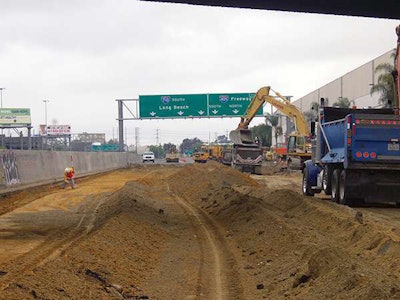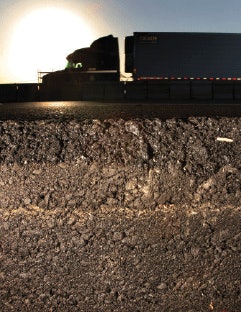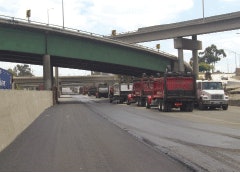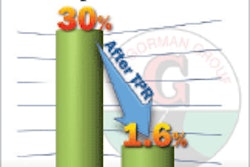The perpetual pavement project on California’s I-5 has sparked a trend in the state for asphalt pavements designed to last 40 years with minimal maintenance.

As traffic whizzed nearby on busy Interstate 5 in California, Shirley Choate and Chris Cummings watched an asphalt paving operation like proud parents. This wasn’t just any paving job. An innovative, long-life asphalt pavement project was starting to take shape on a section of the busy interstate, California’s backbone of commuting and commerce that stretches nearly 800 miles from Mexico to the Oregon border.
For Choate, the deputy director for the California Department of Transportation’s (Caltrans) District 2, and Cummings, the Caltrans area construction manager, the paving work culminated months of planning, preparation, design work and coordinating with numerous interested parties – including industry, academia and the contractor community.
The goal of the $17.5 million, 6-mile project near the community of Weed, as well as another nearby $31 million, 14.5-mile project near the community of Red Bluff, was to produce asphalt pavements designed to last 40 years or more with minimal maintenance. The North State work represented a breakthrough in California for the concept of long-life asphalt pavement (LLAP), also known as Perpetual Pavements. Building on the success of a project on the truck-heavy 710 Freeway in Los Angeles County, Caltrans designated the two stretches of I-5 for the design strategy and later put out a long-life asphalt pavement project on Interstate 80 between Sacramento and the San Francisco Bay Area. Other potential candidate projects are in the planning stages.
“The Department is excited about the progress being made in the long-life pavement arena,” says Peter Vacura, chief of asphalt pavement for Caltrans. “With the development of the mechanistic-empirical design methodology, we can design and construct 40-plus year-life pavement with greater reliability, lower cost and less long-term maintenance.”
The Asphalt Pavement Alliance (APA) defines long-life asphalt pavement as “an asphalt pavement designed and built to last longer than 50 years without requiring major structural rehabilitation or reconstruction and needing only periodic surface renewal in response to distresses confined to the top of the pavement.”
 PMA was used in the top 3 inches of this project, and AR-8000 was used in the other layers, including the 3-inch-thick, “rich bottom” layer. The variability in structural pavement thickness is concentrated in the varying thickness of the middle layer(s).
PMA was used in the top 3 inches of this project, and AR-8000 was used in the other layers, including the 3-inch-thick, “rich bottom” layer. The variability in structural pavement thickness is concentrated in the varying thickness of the middle layer(s).Long-life asphalt pavements offer several advantages over conventional pavements, including lower life-cycle cost, lower user-delay costs, reduced environmental impact and greater worker safety.
The roots of the LLAP movement in California can be traced back to a presentation in 1995 by Caltrans materials engineer Bill Farnbach, who announced the department was looking closely at longer-life pavement strategies. Next, a location to try out the strategy was identified: the Long Beach Freeway, or I-710, where tens of thousands of cars and trucks jockey for position near the massive Port of Los Angeles-Long Beach complex. It was one of the toughest tests imaginable. The dual port together handles more than 40 percent of the nation’s Asian imports and ranks as the sixth busiest container port in the world. Caltrans estimates the adjacent freeway carries in the neighborhood of 150,000 vehicles a day near Pacific Coast Highway, of which about 16 percent are big rigs heading to and from the port facilities.
The I-710 Freeway Rehabilitation, as it became known, began in 2001 and represented a number of “firsts” for the 117-year-old department – the first LLAP project in California, as well as the first use of 55-hour weekend closures to minimize inconvenience to commuters due to construction activity. In addition, as reported in the 2005 issue of California Asphalt magazine, the project was the first time the department used analytically based (mechanistic-empirical) pavement design for both the replacement and overlay pavement structures.
As part of the design methodology, the Strategic Highway Research Program (SHRP) developed shear and fatigue tests for use in the evaluation of the hot-mix asphalt (HMA). Moreover, the special provisions in the contract required the contractor supply the results of shear and fatigue tests for the mixes proposed for use. The requirement was to ensure the mixes actually used exhibited equal or better characteristics than those of the mixes used to design the pavement sections. Also, the compaction requirements for the HMA layers were more stringent than those regularly used by Caltrans.
Chris Gerber, vice president of the infrastructure division for Twining, has vivid memories of the high-profile I-710 project once construction got underway.
“One weekend, there were 26,000 tons of HMA produced from two separate HMA plants,” Gerber recalls. Twining performed material testing on the project and managed the overall quality program. “The contractor had three separate paving operations going at the same time. We had 24 quality-control staff on the project during the extended 55-hour weekend closures. The biggest logistical challenge we had from a quality standpoint was conducting all of the inspections and ensuring the materials met the stringent long-life pavement quality requirements in real-time as the project was being built.”
The I-710 rehabilitation is actually a series of projects stretching several years that could ultimately cost $650 million when the final tally is complete. The work stretches northward from the port, beyond the I-405 intersection to downtown Los Angeles and connecting with busy Interstate 5 and 10. Even among traffic-jaded Angelenos, the reviews have been positive.
“The sensation is palpable, if not slightly remarkable,” the Los Angeles Times gushed in a 2009 profile that appeared on Page 1. “There, you are hurtling in the No. 3 lane on the Long Beach Freeway. Your car is rattling, your tailbone jumping to the rhythm of a concrete washboard abused by years of heavy trucks and piecemeal repairs. Then it happens, between the 105 and Rosecrans. You hit a bump, and suddenly your tires purr, your coffee settles in its cup and the radio reception seems more crisp. You may not know why – it is the nature of freeways that we seldom consider their mechanics – but you are now experiencing the I-710 long-life pavement project, as Caltrans calls it.”
 (Left) A line of asphalt-filled trucks are ready to load the paver on the I-710 long-life asphalt pavement project. (Right) The completed lanes on the I-710, pictured here, are part of a rehabilitation project that is a series of projects stretching several years that could ultimately cost $650 million when the final tally is complete.
(Left) A line of asphalt-filled trucks are ready to load the paver on the I-710 long-life asphalt pavement project. (Right) The completed lanes on the I-710, pictured here, are part of a rehabilitation project that is a series of projects stretching several years that could ultimately cost $650 million when the final tally is complete.To call these projects big is an understatement, and the scrutiny they received was even bigger. Phase 1 included full-depth construction (with a rich bottom layer) and HMA overlays of cracked and seated (C&S) of old Portland cement concrete (PCC) pavements. The performance of Phase 1 is studied on an annual basis (including annual deflection testing). An extensive description of the Phase 1 design and construction can be found in the Journal of the Association of Asphalt Paving Technologists (AAPT); Volume 70 (2001) paper by Carl Monismith, Fenella Long and John Harvey titled, “The Interstate 710 Rehabilitation: Mix and Structural Section Design, Construction Specifications.”
Subsequent work of the 710 LLAP projects was also done on a grand scale. Phase II of the I-710 started in July of 2007 and was scheduled to be complete in 2013. It involves $144 million worth of construction work, of which the paving contract with All American Asphalt amounts to $52.5 million, and more than 400,000 tons of HMA of various types.
The asphalt binders used on the I-710 project preceded the implementation of the PG-grading system in California. As such, PBA-6a, a heavy polymer-modified asphalt (PMA), was used in the top 3 inches, and AR-8000 was used in the other layers including the 3-inch-thick “rich bottom” layer. The variability in structural pavement thickness is concentrated in the varying thickness of the middle layer(s). For overlays of existing cracked pavement layers, the choice of stress relief measure (to avoid reflection cracking), paving fabric or SAMI is dependent on local experience and preference.
Full-depth replacement of existing pavement is typically used under overpasses where the legally required overhead clearance must be met. C&S and overlay of existing, old PCC pavement typically is the most economical solution where overhead clearance is not an issue.
With one major success under its belt, Caltrans looked elsewhere to see where the LLAP pavement strategy made sense. Two different segments of truck-heavy Interstate 5 in the north state immediately jumped to the forefront.
The same success strategy employed on the I-710 projects – a collaborative effort between Caltrans, academia and private industry – was put in place in the North State to get the projects through the design phase, out to bid and then to construction.
They also built on studies, some conducted by the University of California Pavement Research Center (UCPRC), that shed new light on how the stress of traffic loads affect different depths of pavement and impact longevity.
During a tour of the two I-5 projects in 2012, Caltrans regional officials praised the cooperation between industry, academia and the department in moving the two North State projects through the construction phase while overcoming potential obstacles in developing the optimum mix designs, getting timely test results and other logistical challenges.
The first project, valued at $17.5 million, spanned a 6-mile stretch of Interstate 5 in Siskiyou County near the community of Weed. The contractor awarded the project was J.F. Shea Inc. of Redding, California. To the south, a $31-million project was later awarded for 14.5 miles of I-5 near Red Bluff, California. The contractor on that job is Tullis Inc. of Redding, California. Both projects were awarded in 2011, but construction didn’t begin in earnest until 2012.

“We need to credit the team,” says Cummings, a world-weary construction veteran.
The designs for each of the North State long-life projects were custom made, where each layer is optimized for its intended function. The long-life pavement design is based on the concept that if stresses and strains in the bottom of the bound layer are kept below the “endurance limit,” then fatigue of the bound material in tension will not occur, and the main part of the pavement structure should last “in perpetuity.”
Depending on the existing conditions (reconstruction or overlay of existing layers), a different option can be selected. For new full-depth structures, a rich bottom is often the preferred alternative. For overlays of existing pavements (often after milling of the existing HMA surface layers), stress relief measures are included to avoid reflection cracking from cracks in the underlying layers. This can be achieved by incorporating paving fabric or placing a stress-absorbing membrane interlayer (SAMI), comparable to a rubberized chip seal. Often cracking and seating of the cement treated base (CTB) is part of the project approach to further assure reflection cracking will not occur.
An essential and innovative aspect of the long-life projects is the performance test requirements in the design of the mixes. Under these designs, the produced mixes meet performance test requirements at least equal to the performance assumptions used for the pavement structural designs. This involves fatigue, shear and Hamburg wheel track testing.
The top layers of the pavement structure are to be rut-resistant and durable, while the bottom layers are to be fatigue and reflection-crack resistant. This typically means the top 3 inches of the structure is a high-stability layer containing polymer-modified asphalt. In the bottom 3 inches of the bound (asphalt) layers, the fatigue resistance is obtained by increasing the asphalt binder content by 0.5 percent over the optimum binder content (OBC) from the lab mix design, and with that reducing the air-void content after compaction to less than 2 percent. In California, these pavements are capped with a sacrificial layer of asphalt-rubber open-graded porous friction course. Overall, the result is a durable structure designed for many years of service.
One of the key players in the center of the Interstate 5 projects was Byron Berger, the Caltrans District 2 materials engineer. Not one to toss around praise unearned, Berger had the following observation on the two long-life asphalt pavement jobs in his district.
“On a big construction job, it’s rare to see such extensive collaboration between the scientists who developed the long-life design theory, at the University of California Pavement Research Center, the engineering staff that applied the design theory to the project, the Caltrans’ Headquarters Pavement Program and the engineers – District 2 resident engineers Sean Shepard and John Bailey – who were in charge of overseeing construction of the project,” Berger says.
 Bill Farnbach with Caltrans (standing) looks over some preliminary plans for a long-life asphalt pavement design during a meeting with Rita Leahy of CalAPA (left) and Bob Humer with the Asphalt Institute.
Bill Farnbach with Caltrans (standing) looks over some preliminary plans for a long-life asphalt pavement design during a meeting with Rita Leahy of CalAPA (left) and Bob Humer with the Asphalt Institute.“These long-life projects illustrate the application of partnering at its best,” he adds. “From mix-design challenges to interpretation of long-life testing data, Caltrans and the industry successfully worked through the challenges unique to these projects.”
In an interview, Chris Handley with Tullis Inc., the private contractor that built the LLAP project near Red Bluff, says the challenge of a new and complex pavement strategy was daunting at first, but eventually the challenges were overcome.
“I think we were not quite prepared for all the work that must be done in advance to prepare for this job,” Handley notes. “This is not the type of job where you are going to have a mix design in a couple of weeks. You have to identify your reclaimed asphalt pavement (RAP), get samples and then get the test results. There was a lot more to do than a regular paving job.”
Handley says the mandatory pre-job meeting Caltrans held for the project was helpful, but the key event that contributed to the success of the project was when the UCPRC’s Dr. James Signore invited him to visit their lab to see first-hand how they were handling and testing samples. “That was huge for us,” Handley says. “He really opened our eyes. I remember thinking, ‘Wow, this is going to take some work.’”
Working closely with Caltrans to clarify various provisions in the specifications that needed interpretation, constantly communicating with the UCPRC and their own testing lab, Pavement Engineering, Handley says his company was able to work though the issues and keep the project on track.
Unlike the Weed project, the Red Bluff project was more of a standard long-life design, with three pavement layers – a rich bottom layer, a mid-layer utilizing 25 percent RAP and the top layer that used the standard 15-percent RAP permitted under regular Caltrans specifications. The rich bottom proved to be the most problematic, Handley says, because it was the first layer subject to testing. It was a plant-produced, continuous mix that was consistent, but hitting the target values was difficult at first. The data points that were being returned initially varied widely, but everyone worked together to figure out what the test results were telling them and developed a plan to proceed.
“Everyone worked together and realized we have a project to do and need to move forward,” Handley says. “At the end of the day, everything worked out. It was expensive, however, to identify and fix the problems.”
One important lesson learned was the oil contained in the RAP mixture; once the RAP level rose above 15 percent, it created havoc with test results. The compaction targets and other tolerances also were tightened in the specification and difficult to meet, Handley says.
Another unique feature of the Red Bluff project was the complex and expensive traffic control measures that were necessary to keep traffic flowing on a major interstate during construction. The traffic control included lane changes, switchovers and the use of California Highway Patrol (CHP) officers to ensure motorists were driving safely through work zones. Faced with such difficult constraints, Tullis ended up utilizing a closed lane to deposit the asphalt on one side of the freeway barrier and then using a shuttle-buggy to scoop up and deposit the asphalt on the other side of the freeway. That innovative bit of staging, plus consistency and keeping control of the mix, enabled Tullis to keep the project running smoothly, Handley says.
Feedback from the other I-5 LLAP contractor, J.F. Shea, who performed the work on the project near Weed, was also positive.
“The LLPP that we are currently working on is the first project of its kind in Northern California, where we have a lot of variables to deal with such as climate, aggregates and now a new specification in California’s competitive market,” says Juan Bernardino, plant manager for J.F. Shea Construction Inc. “During this project, we had a lot of hurdles to jump over, but we were able to succeed thanks to our construction management, crews, plant personnel, office staff and the help of our materials consultant, CGI Technical Service, along with a good working relationship with Caltrans and the Caltrans District 2 materials lab.”
 Carl Monismith with the University of California Pavement Research Center directed a report that evaluated the 710 long-life asphalt pavement project and presented on the report’s findings at numerous forums.
Carl Monismith with the University of California Pavement Research Center directed a report that evaluated the 710 long-life asphalt pavement project and presented on the report’s findings at numerous forums.Bernardino also praised the help and guidance of Dr. James Signore of the University of California Pavement Research Center. “We all have come to a better understanding of LLAP specifications,” Bernardino says, but he offered a word of caution to future bidders. “It will take three or more months just to complete the mix design portion. For those bidding the LLAP projects, make sure you read and understand these new specifications prior to bidding.”
Meanwhile, Caltrans identified another long-life asphalt pavement project on Interstate 80 in Solano County between the communities of Vacaville and Dixon on a busy interstate that connects the Sacramento area with the San Francisco Bay Area. The engineer’s estimate for the project is $45 million, and it was awarded to venerable California road-builder Teichert Construction, which has been in business continuously in the Golden State since 1887. The company proudly bears California contractor License No. 8. Shortly after his company won the competition to build the project, longtime Teichert materials expert Ron Stickel was asked his reaction. “A lot of testing,” he says.
As was done for the I-5 and I-710 projects, Caltrans District 4, which covers the Bay Area, scheduled an informational pre-bid meeting for prospective bidders. The asphalt industry sent subject-matter experts to provide “best practices” information from previous projects in California and elsewhere.
With the LLAP strategy taking hold in California, it’s clear that the many lessons learned from the first few projects will come in handy again and again.
For more information about long-life asphalt pavements, visit the California Asphalt Pavement Association (CalAPA) site at calapa.net.
Here is a look at some of the many lessons the Caltrans team learned on the I-710 project:
• Pre-bid conference should be mandatory for all potential bidders.
• For projects of this importance, a partnering meeting at the outset should be mandatory.
• For new test procedures in the special provisions, ensure all involved groups test and analyze resulting data the same way.
• Human resources during the process were “stretched,” so a number in succession 3 to 5 maximum with 1 or 2 weekends in between is recommended.
• Contractor should select closure locations.
• Input from meteorologists is important for contractor for weather forecasting for 55-hour closures.
• Contingency planning is extremely important; in this case, aggregate supply for working platform was locally available.
About the authors: Bob Humer is the regional engineer for the Asphalt Institute. He is a licensed Professional Engineer in California. Russell W. Snyder is executive director of the California Asphalt Pavement Association.
WEB EXTRA: Only at BetterRoads.com. Long-life asphalt pavement: Red Bluff lessons. Caltrans Senior Engineer Sean Shepard (I-5 Red Bluff job) and Caltrans Resident Engineer John Bailey (I-5 Weed job) share lessons learned on the Long-life Asphalt Pavement Projects on Interstate 5.












